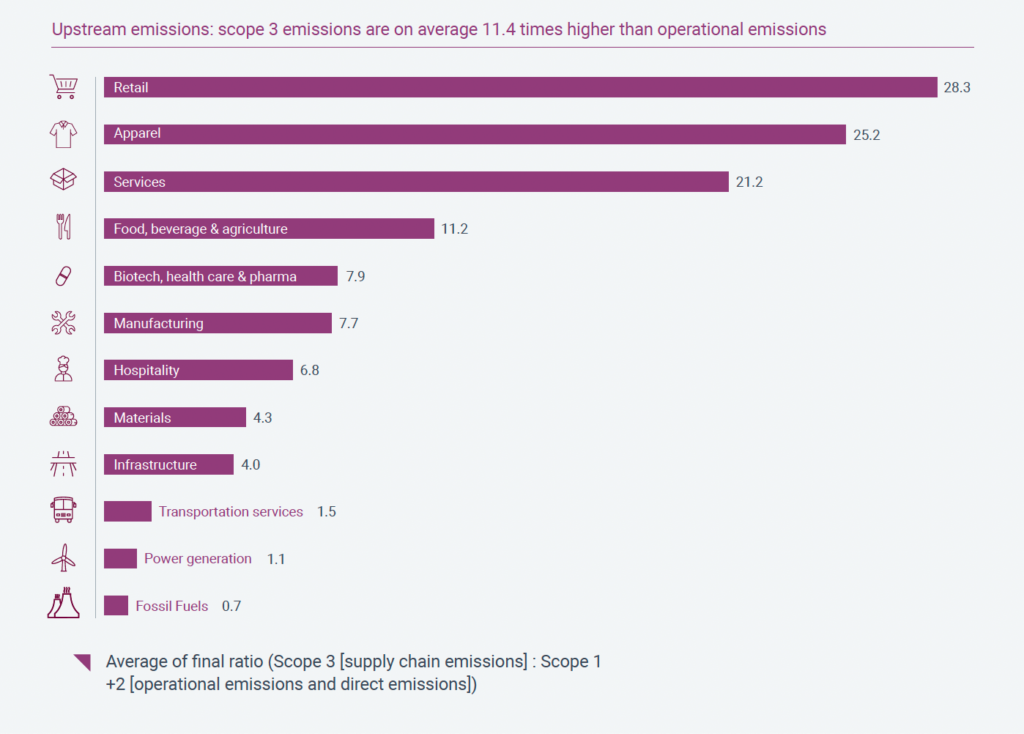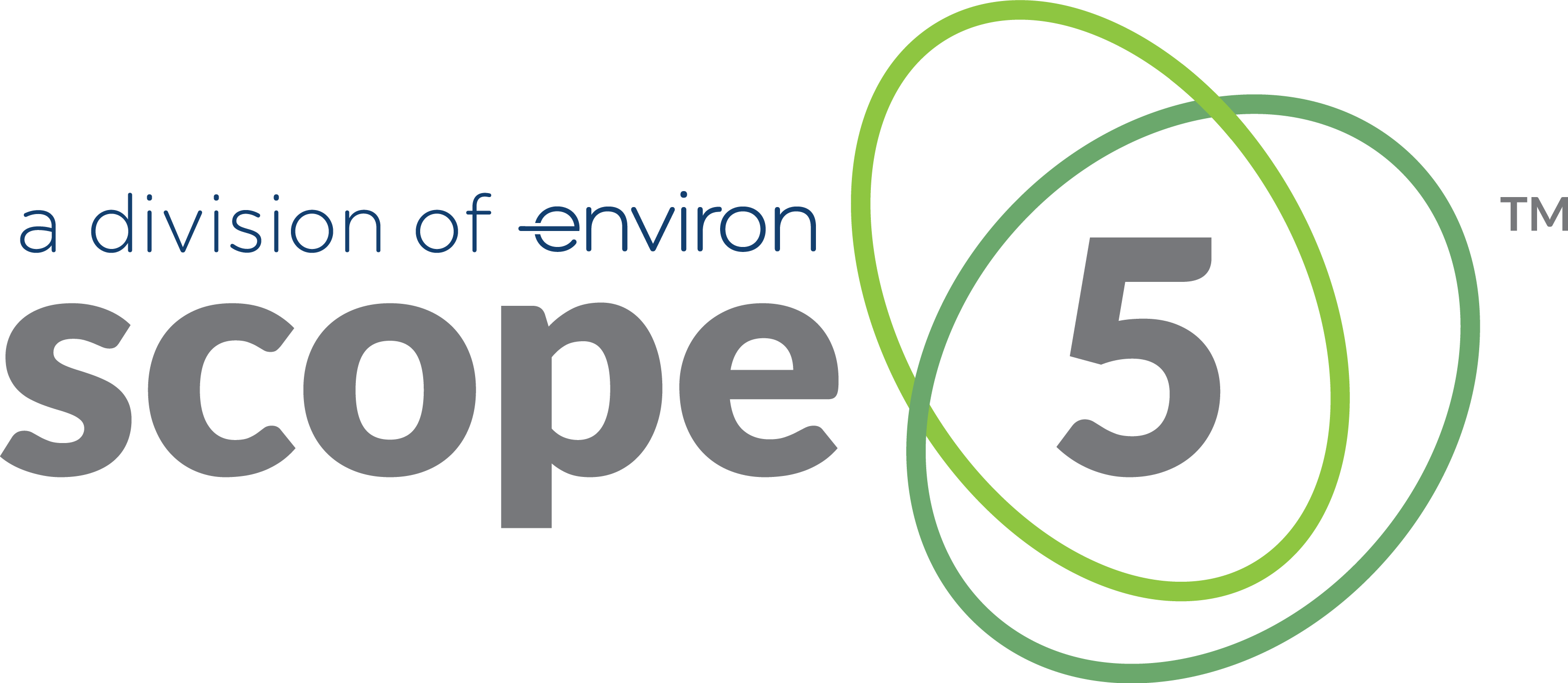Sustainability is at the core of what we do at Scope 5. While helping companies track, report, and take action on their sustainability targets, we’ve noticed increased attention to Scope 3 emissions. What are they, why are they important, and what can companies do to mobilize in reducing them?
A company’s carbon emission output can be classified into three categories under the GHG Protocol Corporate Accounting and Reporting Standard. These categories are designated Scope 1, 2, and 3.
Scope 1 includes direct greenhouse gas emissions that occur from sources under a company’s control, including boilers, heaters, furnaces, and vehicles onsite at company facilities. Scope 2 includes indirect greenhouse gas emissions resulting from the purchase of electricity, steam, cooling, and heating of the company’s facilities.
While reporting on Scope 1 and 2 emissions is required by the GHG Protocol Corporate Accounting and Reporting Standard, there is a growing focus on Scope 3 to further analyze and act on major emission generating activities.
What is Scope 3?
Scope 3 consists of indirect greenhouse gas emissions from sources beyond direct operations, within the greater value chain – from business travel and employee commuting to product processing. The Greenhouse Gas Protocol’s “Corporate Value Chain (Scope 3) Accounting and Reporting Standard” defines these emissions that companies are indirectly responsible for into fifteen categories both upstream and downstream throughout the value chain.

How Can Businesses Address Scope 3 Emissions?
With increased attention on the size and significance of Scope 3 emissions, companies are now focusing on understanding their supply chain footprint. Scope 3 is an area where businesses can take action on some of the most impactful activities within their carbon footprint, including areas like procurement, waste, transportation of both raw materials and sold products, employee commuting, and business travel. However, with so many categories to quantify and analyze, it’s easy to become overwhelmed. You may be wondering; how can your business get started in quantifying your Scope 3 emissions?
It’s important to first determine the categories of Scope 3 that are pertinent to your business. Is procurement the largest likely source of Scope 3 emissions? Does your company rely heavily on third-party transportation of sold products? Are your products easily recycled? How far are materials transported to manufacturing facilities?
It is also important to consider the areas of business where you are most likely to drive change (keep in mind this may not be the category generating the most emissions). For example, while business travel may not be the biggest source of your Scope 3 emissions, it may be relatively easy to address by setting company-wide business travel policies. On the other hand, while procurement activities may make up the largest source of emissions, driving reductions in this category could require lengthy internal discussions on choosing more sustainable vendors.
While these questions are certainly company and industry-specific and may require deep internal review, below is an overview of a few Scope 3 categories to help you get started.
Purchased Goods and Services (Procurement)
Engaging suppliers to assess the upstream emissions for a company’s purchased goods and services can seem daunting. The Greenhouse Gas Protocol guidance provides flexibility in calculating emissions based on available data so any company can get started to establish a baseline using secondary or industry average data before reaching out to suppliers. Starting with a baseline can then help prioritize which procurement categories or suppliers are good candidates to focus on to collect specific activity data.
Transportation
Companies can have a direct influence on the reduction of Scope 3 emissions by making alterations to the transportation of both materials used in manufacturing and the distribution of their sold products. Reducing distances traveled, the weight of products (and their packaging), changing the fuel type, or even the mode of transportation are all ways to impact emissions generated in this category.
Companies can have a direct influence on the reduction of Scope 3 emissions by making alterations to the transportation of both materials used in manufacturing and the distribution of their sold products. Reducing distances traveled, the weight of products (and their packaging), changing the fuel type, or even the mode of transportation are all ways to impact emissions generated in this category.
Business Travel
For certain types of companies, business travel has historically been a normal part of everyday business. While the Covid-19 pandemic alternated many corporate travel patterns, travel rebounded throughout 2021 and will remain an area of opportunity to address Scope 3 emissions. Perhaps there is an opportunity for your company to incorporate more virtual meetings or conferences into daily practice after proven success during the pandemic.
End-of-Life Treatment of Sold Products
Once a product has fulfilled its usefulness, the end-of-life disposal method generates emissions dependent on if the product is sent to a landfill, recycled, composted, or incinerated. Creating products using materials that can be recycled or sourcing materials made of post-consumer recycled material are potential ways to reduce the quantity of emissions.
Waste
Additionally, waste that is generated during operations at facilities is another area to consider. Though the waste and recycling market varies regionally, it’s worth exploring if increasing waste diversion from landfills throughout operations could be a key area to drive change within your organization.
How Can Progress be Made?
Start with a general assessment of all Scope 3 categories within your company’s operations. Begin calculating the emissions where data is available or where secondary industry data such as the United States environmentally-extended input-output model (USEEIO), can be used as an initial assessment.
Once the significant categories have been identified, engage those partners both up and down the value chain to find opportunities for data sharing and collaboration to drive emission reductions.
In parallel, you can work towards setting reduction targets. Scope 5 advises our customers to set science-based emissions reduction targets in accordance with the Science Based Targets initiative (SBTi). There are plenty of organizations that can help you find ways to both understand and reduce emissions, and many companies identify opportunities and solutions inspired by their own teams.
Scope 5’s sustainability data management software helps our clients easily track and manage their data so they can accelerate progress and meet their sustainability goals. We support companies large and small to help them tackle their toughest sustainability challenges. We’d love to hear from you – reach out to our team!
